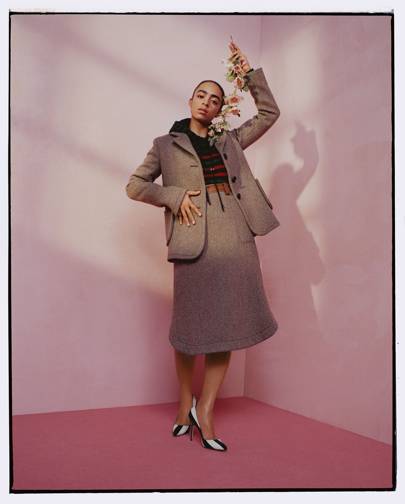“I believe that Wales Bonner is an important brand for the times we are living in,” she explains. “The brand was conceptualised as a means to elevate the location of blackness within the fashion landscape, and to disrupt traditional European notions of luxury with a hybridity and multiplicity of perspectives.” To put it bluntly: in an industry that has long skewed Eurocentric and historically been whitewashed both on the runways and behind the scenes, Wales Bonner is writing a new narrative.
“Grace is a designer with a very clear point of view,” reflects Vogue editor-in-chief Edward Enninful. “Her clothes are fully realised – you can immediately recognise a Wales Bonner silhouette and attitude, which is amazing for someone so young – and her work is like a form of art. Her influence extends far beyond fashion; not only does she have a growing ready-to-wear business, but what she’s already done for culture would be impressive in someone twice her age.”
Through imbuing her designs with intricate explorations of diasporic histories – from the stately dress of Haile Selassie to the transitional wardrobe of Ethiopian slave and military leader Malik Ambar – Wales Bonner has been, since its very inception, bringing marginalised voices to the front of the conversation.

But while that missive holds plenty of merit, it is rare to see it translate into the fashion arena with such elegance. Wales Bonner’s careful subversion extends into her ready-to-wear, informing tailoring that gently pushes against gender conventions, infusing masculine cuts with a subtle fetishism and womenswear with quiet power; or elevating slouching casualwear through intricate embroideries and hand-woven brocades. Her ability to disrupt binaries – of race, gender, culture – is profoundly impressive – but even more so the fact that her studied investigations materialise in brilliant clothing.
For her autumn/winter 2019 collection, her first explicitly co-ed fashion show, Wales Bonner invited her audience to the Serpentine Galleries, where she was in the middle of staging a multi-disciplinary exhibition, A Time For New Dreams, curated to explore how spirituality manifests in black aesthetic and cultural practices. To the sounds of writer Ishmael Reed playing the piano, she presented a collection that was as deeply-considered as her work ever is, taking the tropes of collegiate Americana and refracting them through a prism of black mysticism: baseball shirts fringed with feathers; tweed tailoring decorated with talismanic brooches.
But whether you had read Reed or not; knew the name of the outsider printed across varsity bombers; sought to understand the motives behind embroidered initials that resembled voodoo vévés, or simply admired their shimmering curlicues, her clothes stood strong simply on aesthetic merit. That’s one of the best things about Wales Bonner: that her meticulously-researched backstories, compelling as they are, are simply an added bonus. A few weeks ago, she said: “It is my ambition to build a brand that comes from a black cultural perspective and has the same authority, presence and impact as any esteemed European house. In the long term, I want Wales Bonner to exist on that same level.” Today proves she is well on her way.

But while that missive holds plenty of merit, it is rare to see it translate into the fashion arena with such elegance. Wales Bonner’s careful subversion extends into her ready-to-wear, informing tailoring that gently pushes against gender conventions, infusing masculine cuts with a subtle fetishism and womenswear with quiet power; or elevating slouching casualwear through intricate embroideries and hand-woven brocades. Her ability to disrupt binaries – of race, gender, culture – is profoundly impressive – but even more so the fact that her studied investigations materialise in brilliant clothing.
For her autumn/winter 2019 collection, her first explicitly co-ed fashion show, Wales Bonner invited her audience to the Serpentine Galleries, where she was in the middle of staging a multi-disciplinary exhibition, A Time For New Dreams, curated to explore how spirituality manifests in black aesthetic and cultural practices. To the sounds of writer Ishmael Reed playing the piano, she presented a collection that was as deeply-considered as her work ever is, taking the tropes of collegiate Americana and refracting them through a prism of black mysticism: baseball shirts fringed with feathers; tweed tailoring decorated with talismanic brooches.
But whether you had read Reed or not; knew the name of the outsider printed across varsity bombers; sought to understand the motives behind embroidered initials that resembled voodoo vévés, or simply admired their shimmering curlicues, her clothes stood strong simply on aesthetic merit. That’s one of the best things about Wales Bonner: that her meticulously-researched backstories, compelling as they are, are simply an added bonus. A few weeks ago, she said: “It is my ambition to build a brand that comes from a black cultural perspective and has the same authority, presence and impact as any esteemed European house. In the long term, I want Wales Bonner to exist on that same level.” Today proves she is well on her way.

No comments:
Post a Comment